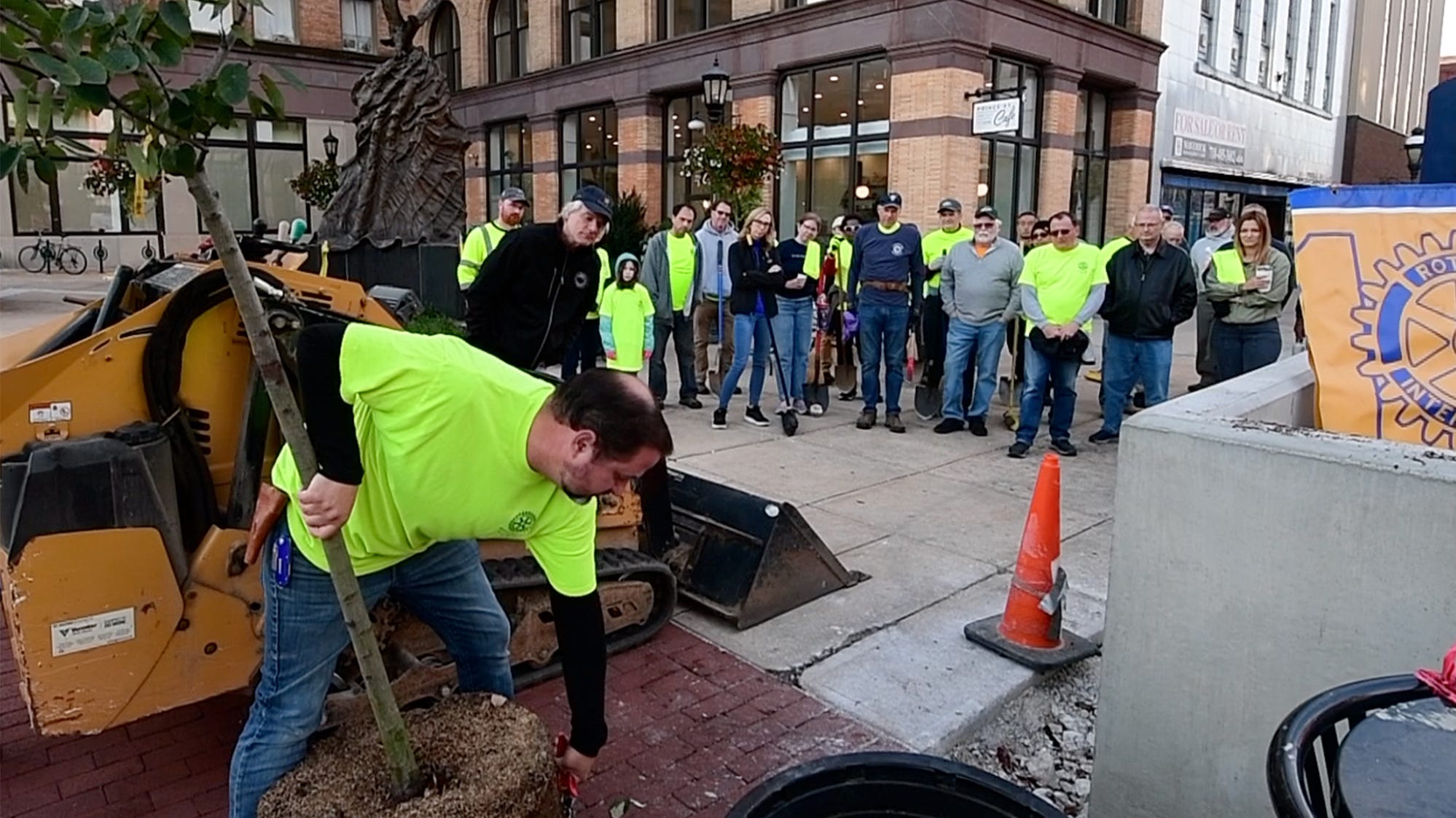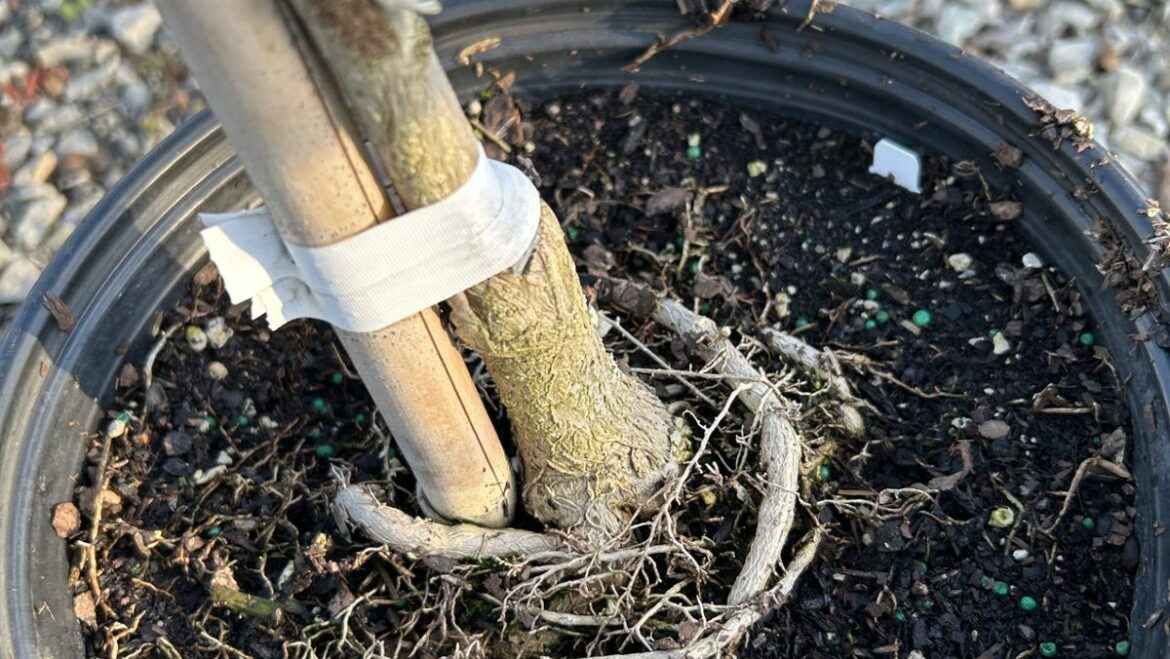Doug Canan/Master Gardener
| Special to The Times

Over 60 trees planted in York PA replacing iconic Bradfords Pears
Rotary representative Aaron Jacobs teaches 50 volunteers how to plant 63 new Serviceberry and Ginkgo trees in downtown York.
So, you picked out the perfect place to add a tree this fall. Since most nurseries and garden centers have trees and shrubs on sale that they don’t want to overwinter, this is a good time to pick out a tree and get it planted before winter sets in.
Be aware, however, that quantities are limited, so you need to act quickly! The ground is still warm, and we are getting a bit more rain, which makes fall the optimum time to plant trees and shrubs. The following guidance will give your new tree the best chance of acclimating before winter.
Most trees are either available in large pots or “Balled-and-Burlapped” (B&B). The B&B trees are often bigger than potted trees with the root ball secured by a wire basket, making them a bit harder to manage. The burlap that growers use is either natural burlap or synthetic burlap. If your nursery cannot tell you which is which, simply ignite a small portion of the burlap with a lighter. If it is natural burlap, it will burn; if synthetic burlap, it will melt; more on the importance of that later.
At this late date, most trees you purchase will be root-bound and are anxious to get into the ground where their roots can spread. The day before you plant, water your tree heavily so all those roots can be wetted. Because the roots are so tight, even heavy watering when you plant may not wet all the roots sufficiently.
Planting depth is critical. To determine the proper planting depth, locate the root flare of your tree, which is where the root system begins to spread laterally from the trunk. When planting is complete, the root flare should be at or slightly higher than the soil level. Planting deeper can result in rotting of the trunk or root death.
If you are planting a B&B tree, best practice dictates removing the wire basket carefully so as not to destroy the root ball. Leaving the basket intact could cripple the root structure of your tree since it can take up to 30 years to degrade. If your root ball is covered with synthetic burlap, remove it prior to planting. Synthetic burlap does not degrade, and trees will not survive more than a few years if this synthetic material is left intact. For root balls covered in natural burlap, cut and remove the top section from the root ball, or cut and roll it down beneath the soil surface and cover it with backfill soil.
Dig the hole approximately twice the width of the root ball and to a depth where the root flare remains even or slightly above the soil level. Taper the hole so the top of the hole is wider than the bottom. Score or roughen the sides and bottom of the planting hole to break up any smooth or glazed surface caused by the shovel during the digging process.
Place your tree carefully into the planting hole. Backfill with good soil. If you have good-quality soil, no additional soil amendments are necessary. If you have heavy clay soil, you may want to mix an organic supplement with your existing soil to allow for better drainage and root spread. No fertilizer is necessary at this time since excessive fertilizer could cause root burn to the tender roots. Add, then gently pack the soil around the root ball until approximately two-thirds of the hole is filled. Use a gentle stream of water to fill the hole and settle the soil. Determine from all sides that your tree is straight and planted at the proper height using the root flare as your reference, then add soil to complete the planting process. Provide a ring of soil several inches high around the edge of the planting hole to serve as a catch basin for water. Add several inches of mulch to aid in water preservation and weed inhibitor as part of the catch basin, ensuring that the mulch does not come in contact with the tree trunk.
Planting a potted tree is similar to planting a B&B tree with a few exceptions. Remove your tree from the pot before planting. If your tree is root-bound or the root mass is growing in a tight, compact circle around the root ball, use a sharp knife to cut the outer roots in four or more places from the top of the root ball to the bottom. Cut an “X” across the bottom of the root ball to free the roots in that section as well. Massage the roots to free them as best you can to allow for quicker contact with the backfill soil and subsequently, the planting hole. Follow the previous instructions for planting a B&B tree for your potted tree. See, that wasn’t too hard!?
A couple of precautions to consider: if your tree has roots that encircle the trunk around the root flare area, cut them to prevent girdling that will eventually kill your tree. The same goes for roots encircling the root ball of potted trees. Watering is critical for acclimating your tree to its new location. Prevent overwatering by inserting your finger into the soil to approximately 1 inch; if your finger comes back wet, no watering is necessary at that time. Less frequent and deeper watering is preferred so that the water goes deep into the root area instead of the roots growing towards the surface seeking water when shorter, frequent waterings are used.
Well, readers, this should help you successfully plant your new tree. Visit your favorite nursery and get a bargain before it’s too late. For research-based information on this or any other plant question, contact the Beaver County Master Gardener hotline at beavermg@psu.edu.
Doug Canan is a Penn State Master Gardener in Beaver County.


Comments are closed.